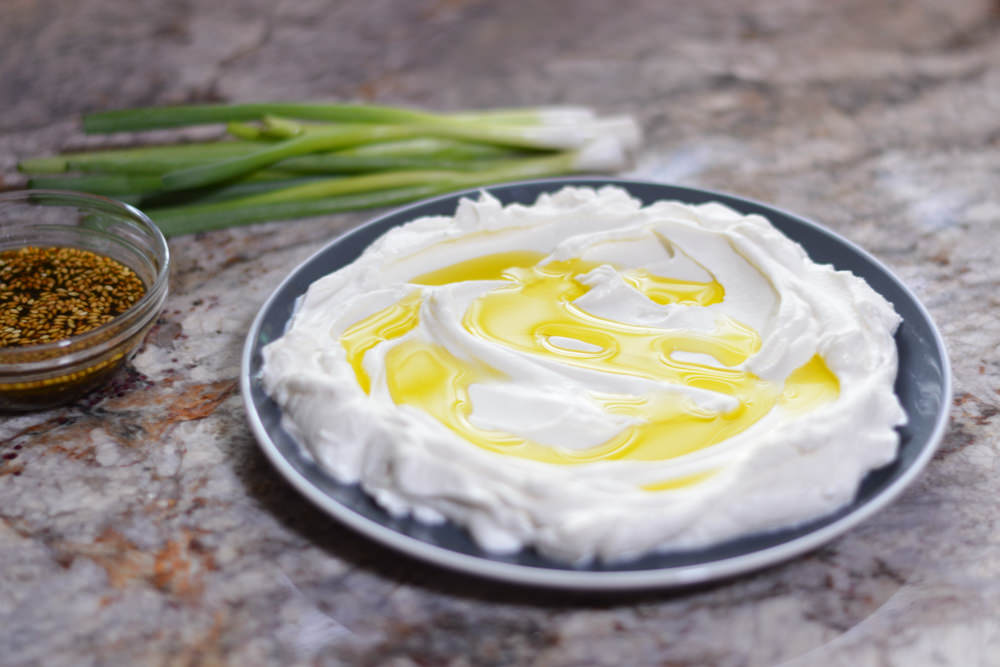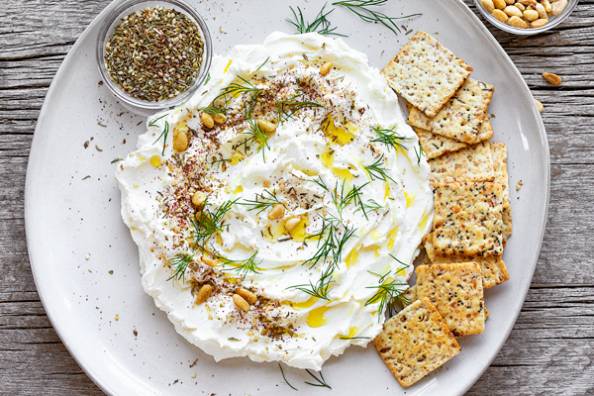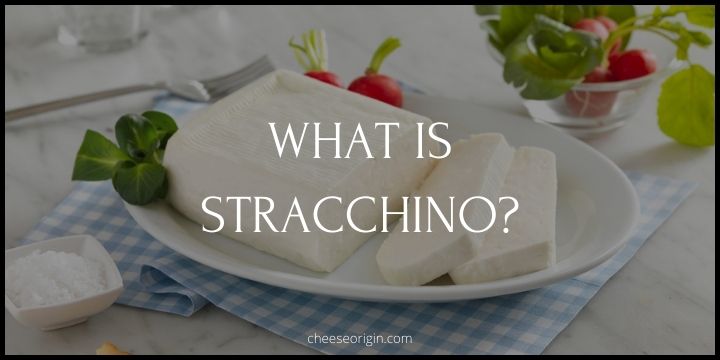What is Labneh Cheese? A Middle Eastern Culinary Secret

Step into the world of Middle Eastern cuisine, and you’ll find a culinary secret that has been savored for centuries – Labneh. This tangy, creamy delight, often mistaken for cheese, is actually a type of strained yogurt cherished across the region. Whether it’s spread on warm flatbread or used as a dip for crunchy vegetables, Labneh has become a staple in Middle Eastern households.
But what exactly is Labneh, and how did it earn its spot in the pantheon of great cheeses? In this blog, we will peel back the layers of this Middle Eastern gem to uncover its unique characteristics, its nutritional benefits, and the versatile ways it can be used.
Quick Facts About Labneh
| Quick Facts | Details |
|---|---|
| Origin | Middle East |
| Also Known As | Yogurt Cheese |
| Texture | Creamy and smooth |
| Taste | Tangy, slightly salty |
| Color | White |
| Made From | Strained yogurt |
| Fat Content | Low to moderate |
| Popular Uses | Dips, spreads, desserts |
| Health Benefits | High in protein, probiotics |
| Shelf Life | Longer than regular yogurt due to straining process |
| Dietary Suitability | Often suitable for lactose-intolerant individuals |
| Availability | Widely available in Middle Eastern markets, increasingly found in mainstream supermarkets |
| Pairings | Olive oil, fresh herbs, spices, breads, fruits |
| Storage | Refrigerate and consume within a week of opening |
| Variations | Can be found in ‘balls’ preserved in olive oil, or in spreadable form |
What is Labneh?

Labneh, a luscious and tangy cheese that hails from the Middle East, is an exquisite culinary delight that’s been steadily making its way into kitchens around the world. It’s not just any cheese, but a unique hybrid that marries the creamy richness of cheese with the tartness and versatility of yogurt.
Crafted from strained yogurt, Labneh boasts a smooth texture and a slightly salty flavor profile. The process of straining allows excess whey to be removed, leaving behind a creamy, thick substance that holds its own in a variety of dishes. From being spread on warm, toasted bread to being used as a base for dips and desserts, Labneh’s versatility is truly impressive.
One of the fascinating aspects of Labneh is its nutritional value. It’s high in protein and brimming with probiotics, making it a healthier alternative to many other types of cheese. Plus, its fat content ranges from low to moderate, depending on the type of yogurt used in its preparation.
Available in various forms, you may find Labneh as spreadable cheese or as ‘balls’ preserved in olive oil. Its long shelf life, longer than regular yogurt due to the straining process, adds to its practicality. Whether you’re seeking to experiment with new flavors, looking for a healthier cheese option, or simply wanting to explore Middle Eastern cuisine, Labneh is a must-try.
What Does Labneh Taste Like?
Labneh has a distinct, yet delightful taste that sets it apart from other dairy products. Its flavor is often described as tangy and slightly salty, similar to Greek yogurt but with an extra depth of richness. The straining process it undergoes concentrates its flavors, resulting in a more pronounced tartness.
The taste of Labneh also has a subtle creaminess to it, which is balanced by its inherent freshness. This balance makes Labneh a versatile ingredient that can seamlessly blend into both sweet and savory dishes. When served with a drizzle of olive oil or a sprinkle of herbs, the taste of Labneh can be enhanced further, adding an extra layer of complexity to its flavor profile.
In summary, if you’re a fan of yogurt, especially the Greek variety, you’ll likely enjoy the taste of Labneh. It’s a unique culinary delight that offers a refreshing twist on the traditional flavors of cheese and yogurt.
Labneh Tasting Notes
- Flavor Profile: Labneh has a tangy and slightly salty taste, reminiscent of Greek yogurt but richer.
- Texture: It boasts a creamy, smooth texture that can be spread easily or scooped up with bread.
- Aroma: Labneh carries a fresh, dairy scent, not overpowering but subtly inviting.
- Versatility: Its balanced flavor profile allows it to blend seamlessly into both sweet and savory dishes.
- Aftertaste: The aftertaste of Labneh is fresh and clean, leaving a pleasant tangy note on the palate.
- Nutty Undertones: Some variations of Labneh, especially those preserved in olive oil, may have subtle nutty undertones.
What is Labneh Made of?
| Ingredient | Description |
|---|---|
| Yogurt | The primary ingredient in Labneh is yogurt, typically whole milk yogurt for a rich and creamy result. The choice of yogurt can impact the final taste and texture of the Labneh. |
| Salt | Salt is added to the yogurt to enhance the flavor. It also aids in the straining process by helping to draw out more whey from the yogurt. |
| Cheesecloth or Strainer | While not an edible ingredient, a cheesecloth or strainer is crucial in the making of Labneh. It’s used to strain the yogurt and remove excess whey, leading to the thick and creamy consistency of Labneh. |
| Optional: Herbs and Spices | Depending on personal preference, various herbs and spices like mint, za’atar, or pepper can be added to infuse additional flavors into the Labneh. |
| Optional: Olive Oil | Some variations of Labneh are preserved in olive oil, which can add a subtle fruity or peppery note to the cheese. This is more common for Labneh balls. |
What is the Difference Between Labneh Cheese and Greek Yogurt?
| Labneh Cheese | Greek Yogurt | |
|---|---|---|
| Origin | Originates from the Middle East. | Originates from Greece. |
| Preparation | Made by straining yogurt extensively to remove most of the whey. | Made by straining yogurt to remove some of the whey, but not as much as Labneh. |
| Texture | Has a thick, creamy texture similar to soft cream cheese. | Has a thicker texture than regular yogurt, but is more pourable than Labneh. |
| Flavor | Tangier and richer in flavor due to longer straining process. | Less tangy and rich compared to Labneh, but still more so than regular yogurt. |
| Uses | Often used as a spread or dip, can be rolled into balls and preserved in olive oil. | Commonly eaten as is, or used in cooking or baking. Can also be used as a base for dips. |
| Fat and Protein Content | Higher in fat and protein due to the extensive straining process. | Lower in fat and protein compared to Labneh, but higher than regular yogurt. |
| Caloric Value | Caloric value can be higher due to the concentration of nutrients. | Caloric value is usually lower. |
How to Eat Labneh Cheese?
- Spread it on bread: Labneh is often used as a spread on flatbread or toast. You can add a drizzle of olive oil and sprinkle some herbs or spices like za’atar for added flavor.
- Use it in sandwiches: Replace your usual mayo or cream cheese with Labneh. It pairs well with various ingredients such as cucumbers, tomatoes, olives, and even grilled chicken or turkey.
- Make a dip: Labneh makes an excellent base for a variety of dips. Mix it with garlic, lemon juice, and fresh herbs like dill, mint, or parsley. Serve it with pita bread or raw veggies for a healthy snack.
- Serve it with honey or jam: For a sweet treat, spread some Labneh on a piece of bread and top it with your favorite honey or fruit jam. This combination is a common breakfast or dessert in many Middle Eastern countries.
- Use it in baking: Labneh can be used in place of cream cheese in baking recipes. Try it in cheesecakes, muffins, or pastries for a unique twist.
- Pair it with fruits: Labneh goes well with a variety of fruits, especially berries and figs. You can create a simple and healthy dessert by serving a scoop of Labneh with fresh fruits and a drizzle of honey.
- Add it to salads: Use Labneh as a creamy element in your salads. It pairs particularly well with beetroot, cucumber, and tomato salads.
- Create Labneh balls: Roll Labneh into small balls and preserve them in a jar of olive oil with herbs and spices. These can be used later as a delicious addition to salads or pasta dishes.
10 Best Labneh Cheese Substitutes
| Substitute | Description |
|---|---|
| Greek Yogurt | Greek yogurt is thicker and creamier than regular yogurt, making it a good substitute for labneh. It has a similar tangy flavor but is less rich. |
| Sour Cream | Sour cream has a similar creamy consistency to labneh and a slightly tangy flavor. It can be used as a substitute in dips and spreads. |
| Cream Cheese | Cream cheese is thicker and richer than labneh, but it can be thinned down with a bit of milk or cream. It’s a good substitute in recipes where labneh is used as a spread or in baking. |
| Cottage Cheese | Cottage cheese can be blended until smooth to mimic the texture of labneh. It has a mild flavor that can be enhanced with herbs or spices. |
| Ricotta Cheese | Ricotta has a similar creamy texture to labneh, although it’s less tangy. It works well as a substitute in both savory and sweet dishes. |
| Kefir Cheese | Kefir cheese, also known as “kefir grains”, has a similar tangy flavor and creamy consistency to labneh. It’s a good probiotic-rich substitute. |
| Quark | Quark is a type of fresh cheese that has a similar texture to labneh. It’s less tangy but can be used as a substitute in a variety of recipes. |
| Mascarpone | Mascarpone is a creamy Italian cheese that can work as a substitute for labneh, especially in desserts. It’s milder and sweeter than labneh. |
| Fromage Blanc | Fromage blanc is a French cheese with a texture and flavor similar to labneh. It can be used as a substitute in both savory and sweet recipes. |
| Tofu (for vegan alternative) | Blended silken tofu can mimic the creamy texture of labneh. It’s a good vegan substitute, although it lacks the tangy flavor of labneh. It can be enhanced with lemon juice or vinegar. |
What Pairs Well With Labneh?

Food that goes well with Labneh:
| Category | Foods that Pair Well with Labneh |
|---|---|
| Bread | Pita bread, flatbread, multigrain toast, bagels, croissants. |
| Fruits | Figs, dates, pomegranate seeds, olives, avocados, cucumber, tomatoes. |
| Vegetables | Bell peppers, radishes, beetroot, zucchini, eggplant. |
| Herbs & Spices | Mint, parsley, dill, za’atar, sumac, black pepper, cumin. |
| Nuts & Seeds | Pine nuts, almonds, walnuts, sesame seeds, flax seeds. |
| Proteins | Grilled chicken, turkey, smoked salmon, boiled eggs. |
| Condiments | Olive oil, honey, fruit jams, tahini, hot sauce. |
| Grains & Cereals | Quinoa, bulgur wheat, oatmeal, granola. |
| Cheeses | Feta cheese, halloumi, mozzarella. |
| Desserts | Honey drizzled figs or dates, fruit salads, cheesecakes. |
Also read: What Fruit Goes on a Charcuterie Board?
Beverage that goes well with Labneh:
| Category | Beverages that Pair Well with Labneh |
|---|---|
| Tea | Mint tea, chamomile tea, black tea, green tea. |
| Coffee | Turkish coffee, espresso, latte, cappuccino. |
| Juices | Pomegranate juice, orange juice, apple juice, grapefruit juice. |
| Smoothies | Berry smoothies, banana smoothies, green smoothies, avocado smoothies. |
| Wine | Light-bodied white wines like Sauvignon Blanc or Vermentino, rosé wines. |
| Non-Alcoholic Drinks | Lemonade, sparkling water, herbal infusions, iced tea. |
| Spirits & Liqueurs | Arak (anise-flavored liquor), Limoncello, dry gin. |
| Beer | Light beers like lagers or pilsners, wheat beers. |
| Dairy & Non-Dairy Milk | Almond milk, soy milk, oat milk, cow’s milk. |
| Cocktails | Bloody Mary, gin and tonic, mimosas, bellinis. |
Also read: Top 10 Champagne & Cheese Pairings to Try at Least Once
Frequently Asked Questions
1. What is another name for Labneh?
Another name for Labneh is “strained yogurt”.
2. Is Labneh healthier than Cheese?
Yes, Labneh is generally considered healthier than many types of cheese. Labneh is a source of protein and is lower in lactose, making it easier to digest for those with lactose intolerance. It also contains beneficial probiotic bacteria, calcium, and vitamin A. Compared to regular cream cheese, Labneh has fewer calories and fat content.
For instance, regular cream cheese has about 80 calories and 7 grams of fat per 2 tablespoons, while Labneh has around 60 calories for the same amount. However, nutritional values can vary depending on the specific type of cheese being compared and how the Labneh is prepared.
3. How to Store Labneh Cheese?
Labneh can be stored in a few different ways depending on how long you intend to keep it:
- In the refrigerator: Store fresh Labneh in an airtight container in the refrigerator for up to two weeks.
- In olive oil: If you want to preserve Labneh for a longer period of time, form it into balls and submerge them in olive oil. They should be kept in a cool, dark place like your pantry. This method allows the Labneh to keep for up to six months. Another source suggests that Labneh preserved in oil can last up to three months as long as it remains completely submerged.
- In herb oil: Similar to the olive oil method, you can also store Labneh in herb oil. Allow it to age for two days in the fridge for the flavors to develop. This method allows the Labneh to keep for up to a month.
Also read:
- What is Roncal? A Taste of Spanish Heritage
- What is Cheshire Cheese? A Timeless British Delight
- What is Fromage Blanc? Unveiling France’s Creamy White Delight
- What is Saint Andre? A Decadent Delight from Normandy
- What is Blue Castello? The Creamy Danish Delight
- What is Danish Blue (Danablu)? Denmark’s Favorite Blue Cheese
- What is American Grana? Redefining Parmesan in the US





